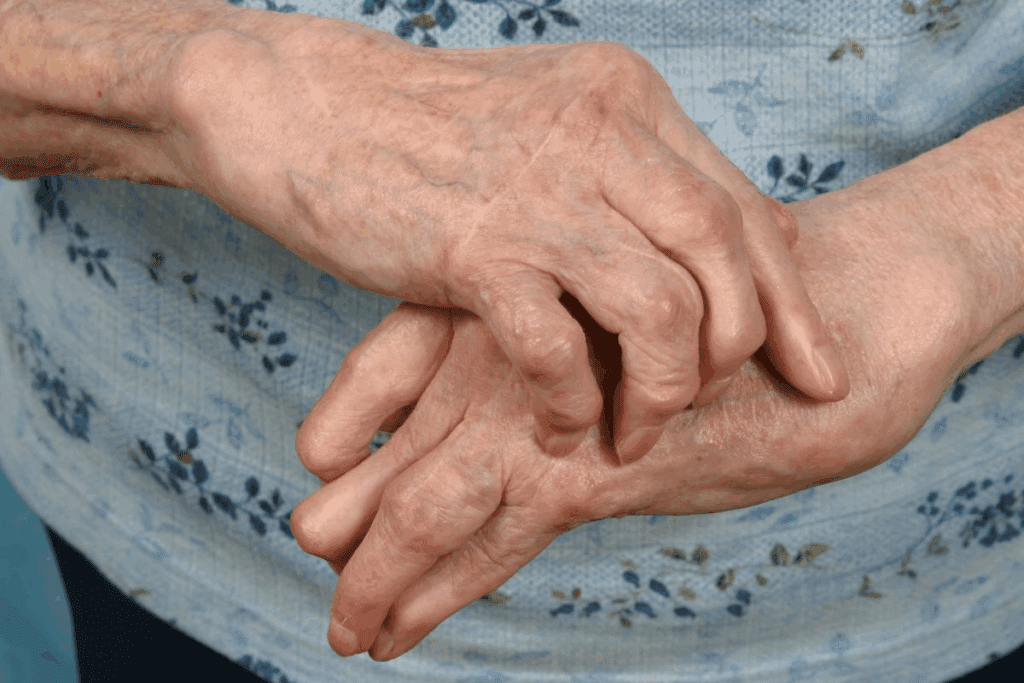Last Updated on November 14, 2025 by

Effectively managing osteoarthritis pain is essential for a fulfilling life. Did you know over 32.5 million adults in the U.S. have osteoarthritis? It’s one of the most common arthritis types.
To calm osteoarthritis, effective management tips include lifestyle changes, physical therapy, and medication. Simple ways to ease symptoms are staying active, eating well, losing weight, and using hot or cold packs.
By using these strategies, people can manage their condition better. This improves their overall health and well-being.

Understanding osteoarthritis is crucial for effectively managing its symptoms and enhancing quality of life. This condition is complex, influenced by age, genetics, and lifestyle.
Osteoarthritis is caused by several factors. These include age, genetics, and wear and tear on the joints. As we age, our joint cartilage can wear down, leading to osteoarthritis. Genetics also play a role, as some people are more likely to get it.
Repetitive strain on joints, from work or hobbies, can also cause osteoarthritis.
The symptoms of osteoarthritis include pain, stiffness, and limited mobility in the affected joints. Pain is often the first sign, happening after rest or inactivity. Stiffness, mainly in the morning, makes it hard to move the joints.
As the condition worsens, limited mobility can affect daily life. It’s key to see a doctor if these symptoms last.

Effectively managing osteoarthritis pain is essential for a fulfilling life.d long-term plans. Finding ways to ease the pain is key to a good life for those with this condition.
Effectively managing osteoarthritis pain is essential for a fulfilling life.
But, long-term pain management is more than just quick fixes. Regular exercise for osteoarthritis keeps joints moving and muscles strong. Staying at a healthy weight is also important to avoid extra joint strain. Sometimes, doctors may prescribe stronger pain meds.
Knowing when to see a doctor for osteoarthritis pain is important. If pain is very bad, doesn’t go away, or comes with other symptoms, get help. Doctors can guide you on the best treatment and help manage your condition.
For those with osteoarthritis, knowing about medication options is vital. These drugs help manage pain, improve function, and boost life quality.
OTC pain relievers are often the first choice for osteoarthritis pain. Acetaminophen and NSAIDs (Nonsteroidal Anti-Inflammatory Drugs) like ibuprofen and naproxen are popular. Acetaminophen works for mild to moderate pain, while NSAIDs reduce pain and swelling.
But, it’s important to take them as directed to avoid side effects like stomach problems or liver damage.
If OTC drugs don’t work, prescription meds might be needed. These include stronger NSAIDs, corticosteroids, or hyaluronic acid injections. Celecoxib is a prescription NSAID that targets COX-2, reducing inflammation with fewer stomach side effects.
Corticosteroid injections can also help by cutting down inflammation in the joint.
Topical treatments like creams, gels, and patches offer localized pain relief. Topical NSAIDs, such as diclofenac gel, are applied directly to the skin over the affected joint. This reduces systemic side effects.
Capsaicin cream, made from chili peppers, can also be effective. It works by lowering the chemical that sends pain signals to the brain.
Always talk to a healthcare provider before starting any new medication. They can help weigh the benefits and risks. This ensures the chosen treatment is right for you.
For those with osteoarthritis, a good exercise and physical therapy plan can really help. Regular activity not only manages symptoms but also boosts overall health.
Low-impact aerobic exercises are great for osteoarthritis because they’re easy on the joints. Swimming, cycling, and brisk walking are top choices. They keep joints moving and reduce stiffness.
Building muscle around the joints is key for support and pain relief. Strength training, done right, can make joints more stable. Start with light weights and slowly add more as muscles grow stronger.
| Exercise Type | Benefits | Examples |
| Low-Impact Aerobics | Improves cardiovascular health, reduces joint stiffness | Swimming, cycling, brisk walking |
| Strength Training | Enhances muscle strength around joints, improves joint stability | Weightlifting, resistance band exercises |
| Range of Motion Exercises | Maintains flexibility, reduces stiffness | Yoga, stretching exercises |
Range of motion exercises keep joints flexible and reduce stiffness. Yoga and stretching are excellent choices. Do these exercises gently and within a comfortable range to avoid extra strain.
“Exercise is a key part of managing osteoarthritis. It reduces pain, improves function, and boosts overall well-being.”
– Arthritis Foundation
Adding these exercises to your daily routine can greatly improve life for those with osteoarthritis.
Effectively managing osteoarthritis pain is essential for a fulfilling life.pies. Heat and cold therapy are among the most effective and simple methods. They can be used alone or together to ease pain and stiffness from osteoarthritis.
Heat therapy relaxes muscles and boosts blood flow to the affected area. It’s great for stiffness and can be applied with a warm bath, heating pad, or warm compress. Applying heat before activities can help improve flexibility and reduce stiffness.
Cold therapy reduces inflammation and numbs pain. It’s best used after activities or when the joint is inflamed. Cold packs or ice wrapped in a cloth can be applied to the affected area. Cold therapy is very helpful during an osteoarthritis flare-up.
Some people find that alternating between heat and cold therapy gives the most relief. For example, start with heat to loosen the joint, then use cold to reduce inflammation. This contrast therapy can be tailored to the individual’s needs and the severity of their symptoms. It’s important to listen to your body and adjust the therapy as needed.
By knowing when to use heat and cold therapy, individuals with osteoarthritis can better manage their symptoms. This can improve their quality of life.
Incorporating anti-inflammatory foods into your diet can significantly alleviate osteoarthritis symptoms. A balanced diet full of nutrients is key in managing the condition. By choosing the right foods, you can lower inflammation and reduce pain.
Some foods are great for fighting inflammation in osteoarthritis. Omega-3 rich fish like salmon and sardines are very helpful. Berries and leafy greens are also good because they’re full of antioxidants.
Turmeric and ginger are also good choices. Turmeric has curcumin, which fights inflammation well. Ginger has been used for ages to lessen pain and swelling.
Some foods can make osteoarthritis worse. It’s best to stay away from processed foods because they often have bad stuff in them. Sugary drinks and foods with a lot of sugar also cause inflammation.
People with osteoarthritis should eat less dairy products and nightshade vegetables. Some people get too sensitive to these foods.
Drinking enough water is important for healthy joints. It keeps joints lubricated and reduces friction. Aim for at least eight glasses of water a day, more if you’re active.
Staying hydrated also lowers the chance of kidney stones and urinary tract infections. These are big problems for people with osteoarthritis.
Some supplements and natural remedies are popular for helping with osteoarthritis. People use them to ease symptoms, along with traditional treatments.
Glucosamine and chondroitin are often used for osteoarthritis. Studies show they might help keep joints healthy and reduce pain. But, results vary, and more research is needed.
The benefits of these supplements could be:
Omega-3 fatty acids in fish oil have anti-inflammatory effects. Turmeric, with curcumin, also has these benefits.
The advantages of omega-3 and turmeric are:
Supplements can be helpful, but safety is key. Always talk to a healthcare professional before starting any supplements. They can interact with medicines or cause side effects.
Important safety points include:
Effectively managing osteoarthritis pain is essential for a fulfilling life.
Keeping a healthy weight is vital for easing joint pressure, mainly in hips, knees, and spine. Even a little weight loss can make a big difference for those with osteoarthritis. A balanced diet and regular exercise are great for staying at a healthy weight.
A weight loss osteoarthritis plan should aim for lasting changes, not quick fixes. It’s wise to work with a healthcare provider or nutritionist to create a tailored plan.
Joint pain can mess up sleep, causing fatigue and more pain. Getting good sleep is key for feeling well. Keeping a regular sleep schedule, having a calming bedtime routine, and using a supportive mattress can help.
Also, sleep tips osteoarthritis patients might find useful include avoiding caffeine and screens before bed. Creating a sleep-friendly environment is also helpful.
Stress can make osteoarthritis symptoms worse, making stress management osteoarthritis vital. Activities like meditation, deep breathing, and yoga can help reduce stress. These practices not only help with osteoarthritis but also boost overall health.
Understanding osteoarthritis is crucial for effectively managing its symptoms and enhancing quality of life.
Understanding osteoarthritis is crucial for effectively managing its symptoms and enhancing quality of life.
Managing osteoarthritis well often means using a mix of treatments. This includes medications, physical therapy, and changes in lifestyle. Heat and cold therapy, nutrition, and stress reduction are also important. They help manage symptoms and boost overall health.
By using these strategies in a detailed management plan, people can better handle osteoarthritis. It’s important to work with healthcare experts. They help create a plan that meets individual needs and supports long-term joint health.
Adding osteoarthritis relaxation techniques, like stress reduction and relaxation exercises, can make the plan even better. This leads to better health and well-being overall.
Effective ways to calm osteoarthritis pain include immediate relief and long-term management. Lifestyle changes are also key. This can include medication, physical therapy, exercise, and nutritional approaches.
Exercise is vital for managing osteoarthritis. Low-impact exercises, strength training, and flexibility routines improve joint health. They reduce symptoms and enhance quality of life.
Incorporating anti-inflammatory foods into your diet can significantly alleviate osteoarthritis symptoms.
Certain supplements like glucosamine and omega-3 fatty acids may help. Turmeric is also beneficial. Always check safety and consult a healthcare professional before using supplements.
During a flare-up, use heat or cold therapy and take pain relievers. Relaxation techniques and resting the joint can also help. Avoid activities that make the pain worse.
Healthy weight, good sleep, and stress reduction are key. These changes can alleviate symptoms and improve life quality. Relaxation techniques and a balanced lifestyle are important.
If symptoms worsen, seek medical help. Increased pain, stiffness, or mobility issues are signs to see a doctor. A healthcare professional can adjust your treatment plan.
While medication helps, it’s not the only solution. Lifestyle changes, physical therapy, and nutrition can also manage symptoms. A healthcare professional can help create a personalized plan.
For better sleep, establish a routine and create a comfortable sleep space. Relaxation techniques and avoiding stimulating activities before bed help. Managing pain is also important.
Subscribe to our e-newsletter to stay informed about the latest innovations in the world of health and exclusive offers!